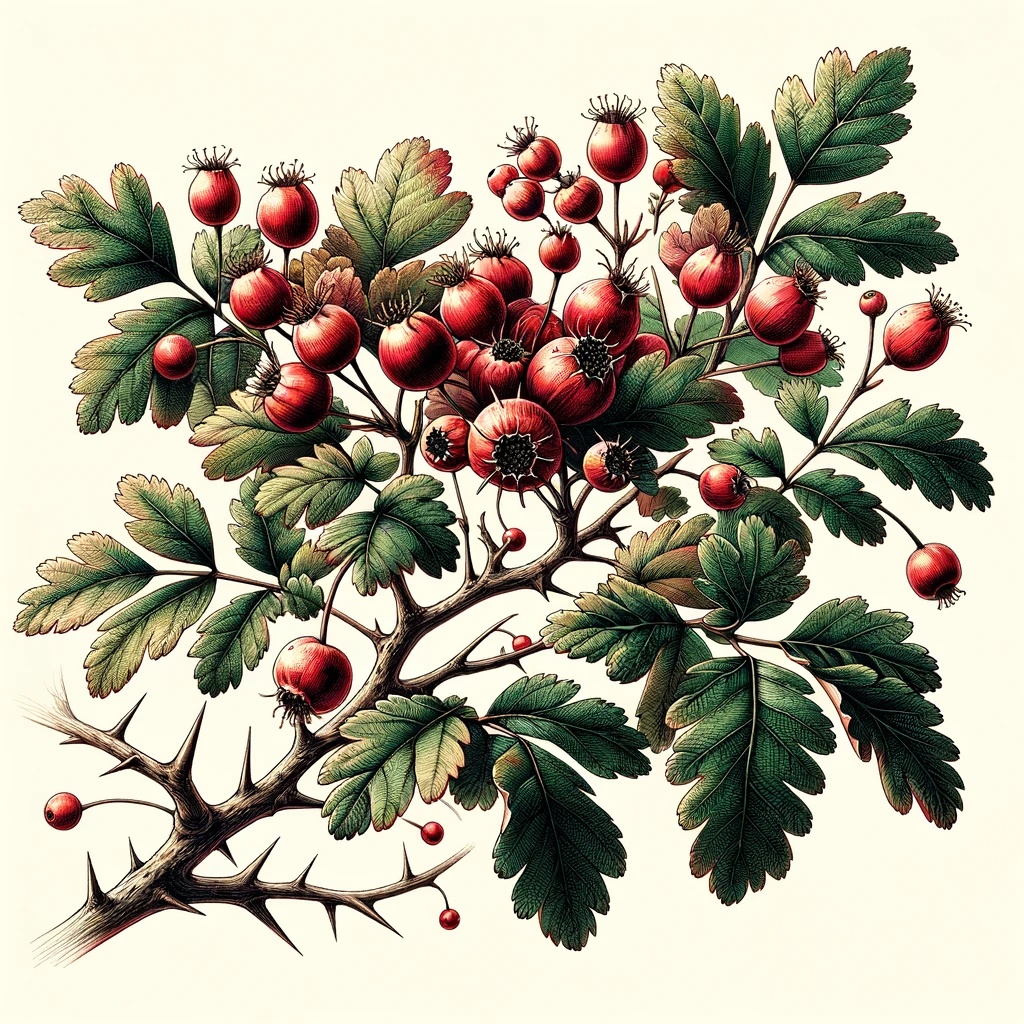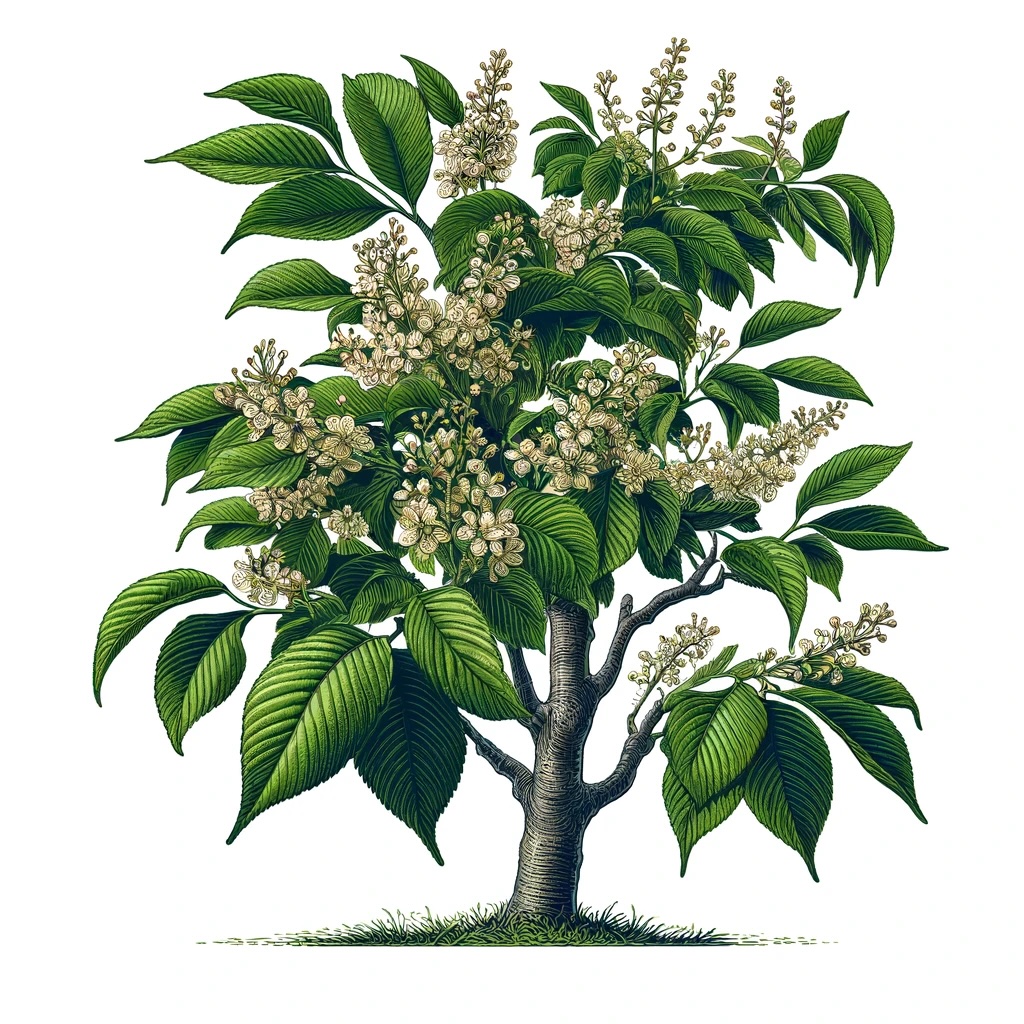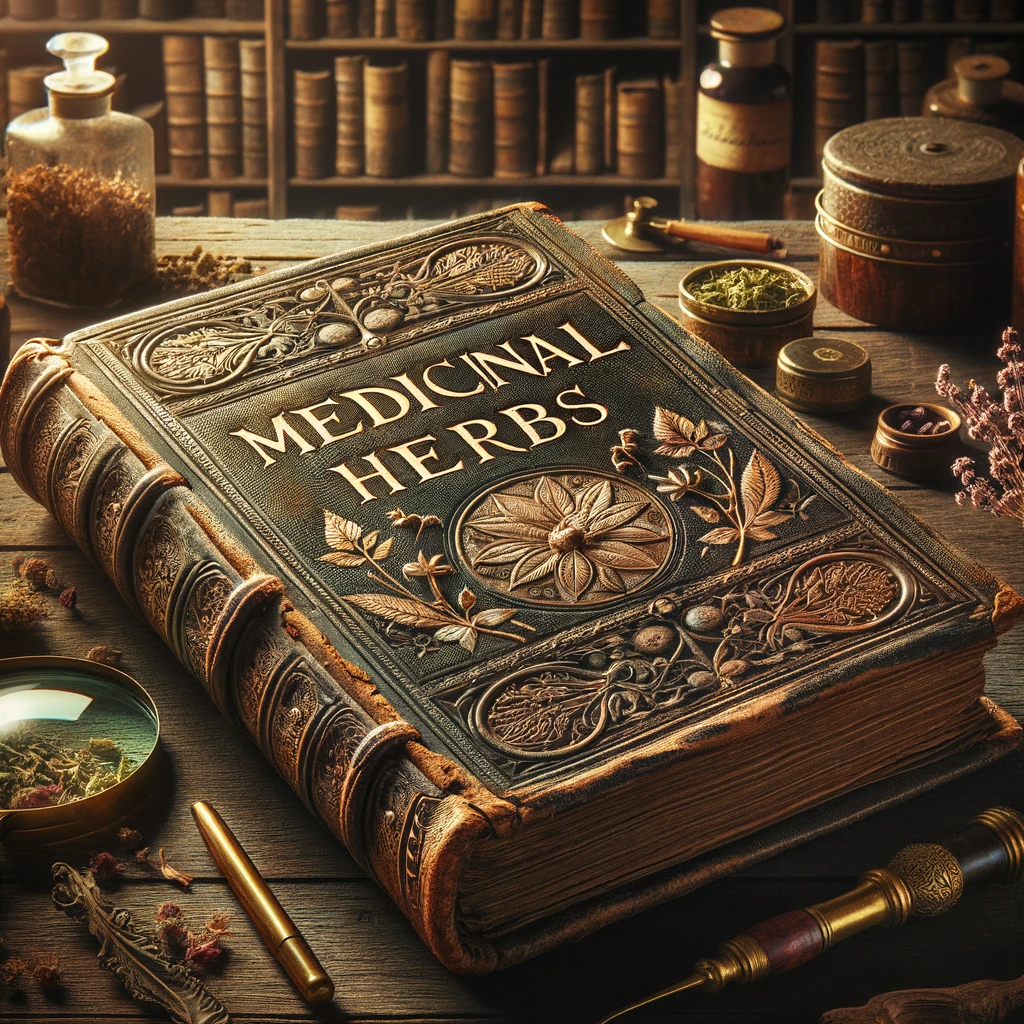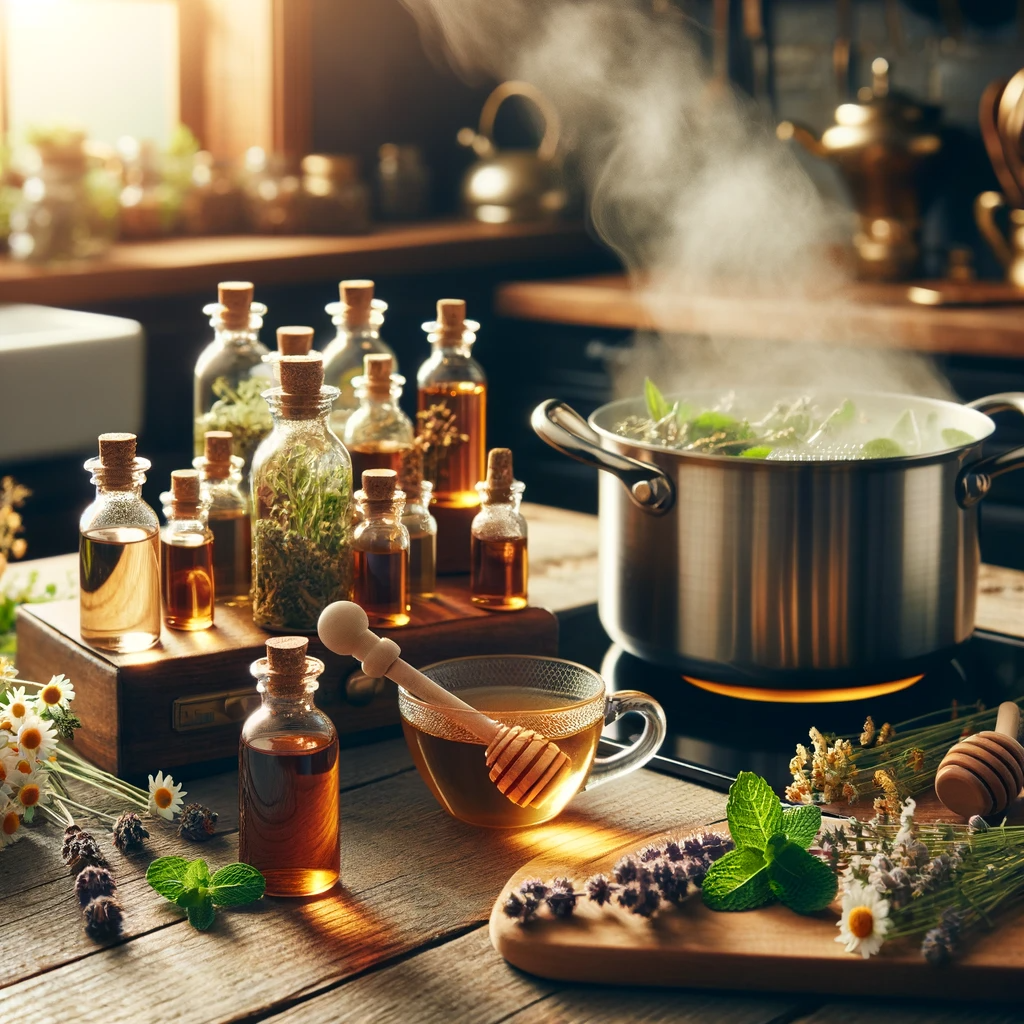This website contains affiliate links for products I use and love. If you take action (i.e. subscribe, make a purchase) after clicking a link, I may earn some tea money, which I promise to drink while creating more helpful content like this.
- Home
- Herb Index
- Monographs
Hawthorn Monograph: A Botanical Overview, Health Benefits & Healing

Imagine a plant that has been a cornerstone in heart health for centuries, beloved across various traditions for its profound impact on cardiovascular wellness. Hawthorn, with its thorny branches and delicate blossoms, has been a revered heart tonic in many cultures.
Hawthorn: The Heart's Guardian in Herbal Healing
Hawthorn (Crataegus spp.) Shrub in a Picturesque Setting
Common Name: Hawthorn
Latin Name: Crataegus spp.
Botanical Overview

Family: Rosaceae
Identification: Hawthorn is identifiable by its thorny branches, lobed leaves, white or pink flowers, and bright red berries, known as haws.
Habitat: Commonly found in temperate regions of North America, Europe, and Asia, Hawthorn thrives in wooded areas and along riverbanks.
Harvesting: The flowers and leaves are collected in late spring, while the berries are harvested in autumn when fully ripe.
Parts Used in Herbal Medicine: Leaves, flowers, and berries.
Herbal Actions
Hawthorn is primarily known for its cardiotonic, antioxidant, anti-inflammatory, and mild sedative properties.
Energetic Qualities
Seen as a nurturing and supportive herb, Hawthorn is often associated with emotional heart health as well as physical.
Taste: The berries, leaves, and flowers have a slightly tart and sweet taste.
Common Preparation Types: Widely used in the form of teas, tinctures, capsules, and extracts.
In the Home Apothecary: Hawthorn can be used in homemade skincare products for its antioxidant properties and as a gentle astringent for mature skin.
Medicinal Uses: Hawthorn’s Healing Virtues
Hawthorn (Crataegus species) stands out in herbal medicine for its profound heart health benefits. Traditionally embraced across many cultures, its berries, leaves, and flowers are used to create remedies that address a spectrum of cardiovascular issues, symbolizing physical and emotional heart healing. Let’s explore the diverse medicinal uses of Hawthorn and how it nurtures the heart and beyond.
Cardiovascular Support
Hawthorn is most renowned for its cardiovascular benefits. It is believed to enhance heart muscle function, increase blood flow, and stabilize heart rhythm, making it a valuable ally in managing conditions such as congestive heart failure, high blood pressure, and angina. Its bioactive compounds, including flavonoids and oligomeric procyanidins, are thought to underpin these effects by improving coronary artery blood flow, reducing arterial blood pressure, and combating atherosclerosis.
Antioxidant Properties
Rich in antioxidants, Hawthorn helps neutralize free radicals that can contribute to chronic diseases and aging. Its anti-inflammatory effects further bolster its role in heart health by reducing inflammation that can lead to heart disease and other health issues.
Anxiety and Stress Relief
Beyond its physical benefits, Hawthorn has a soothing effect on the emotional heart. It is used in herbal medicine to help alleviate anxiety and stress, potentially due to its ability to improve circulation and provide a mild sedative effect. This calming influence is particularly beneficial for those dealing with heart conditions exacerbated by stress.
Digestive Health
Hawthorn also extends its healing touch to the digestive system. It is traditionally used to aid digestion, relieve constipation, and reduce intestinal inflammation. Its digestive benefits are attributed to the herb’s content of fiber and beneficial compounds that help regulate bowel movements and support gut health.
Cholesterol Management
Emerging research suggests that Hawthorn may assist in managing cholesterol levels by lowering the accumulation of fats in the blood and liver. Its antioxidant content helps prevent the oxidation of LDL cholesterol, a key factor in the development of atherosclerosis.
Enhancing Sleep Quality
The mild sedative effect of Hawthorn can contribute to better sleep quality, particularly for those whose sleep disturbances are related to stress or anxiety. By promoting relaxation and easing anxiety, Hawthorn helps create a conducive environment for restorative sleep.
Hawthorn’s wide-ranging medicinal applications underscore its significance in herbal medicine as a heart protector and healer. From supporting cardiovascular health to easing anxiety and improving digestive functions, Hawthorn demonstrates a holistic approach to wellness, nurturing both the physical and emotional aspects of health. As with any herbal remedy, it’s important to consult with a healthcare provider before incorporating Hawthorn into your wellness regimen, especially if you have existing health conditions or are taking medications.
Contraindications
Safety: Hawthorn is generally safe when used as directed but can interact with certain heart medications. It's crucial to consult a healthcare provider before starting any new herbal regimen, especially for those with existing heart conditions.
Precautions: Long-term use should be monitored, and it's advised to be cautious in pregnancy and lactation.
Cultivation Tips
Hawthorn is a hardy shrub that prefers well-drained soil and full to partial sunlight. It's relatively easy to grow and can be a beautiful addition to garden hedges or naturalized areas.
Herbal Ella’s Hawthorn Recipes and Tips
Herbal Ella offers a collection of Hawthorn recipes designed to harness the healing power of this revered herb. These recipes provide a delightful and nurturing way to integrate Hawthorn into your wellness routine, offering support for heart health, stress relief, and overall vitality.
Hawthorn Heart Tonic Tea
Ingredients:
- 1 tablespoon dried Hawthorn berries
- 1 tablespoon dried Hawthorn leaves and flower
- 2 cups boiling water
- Honey or lemon to taste (optional)
Instructions:
- Combine the Hawthorn berries, leaves, and flowers in a teapot or heat-resistant container.
- Pour the boiling water over the herbs and cover.
- Let the mixture steep for 15-20 minutes to allow the active components to infuse.
- Strain the tea and add honey or lemon to taste, if desired.
- Enjoy this tonic tea daily to support your cardiovascular health and to benefit from its antioxidant properties.
Hawthorn Berry Syrup
Ingredients:
- 1 cup dried Hawthorn berries
- 4 cups water
- 1 cup honey
Instructions:
- Combine the Hawthorn berries and water in a pot and bring to a boil.
- Reduce heat and simmer until the liquid is reduced by half, approximately 30-40 minutes.
- Strain the berries from the liquid, then return the liquid to the pot.
- Add the honey to the reduced liquid and simmer on low heat, stirring until the honey is fully dissolved.
- Allow the syrup to cool before bottling. Store in the refrigerator.
- Take 1-2 tablespoons of syrup daily as a heart-healthy tonic, or use it to sweeten teas and beverages.
Relaxing Hawthorn and Lavender Infusion
Ingredients:
- 1 teaspoon dried Hawthorn leaves and flowers
- 1 teaspoon dried lavender flowers
- 1 cup boiling water
Instructions:
- Place the Hawthorn and lavender in a tea infuser or directly in a cup.
- Pour boiling water over the herbs and cover the cup to prevent the escape of aromatic compounds.
- Let it steep for 10-15 minutes.
- Strain (if necessary) and enjoy this soothing infusion before bedtime to ease stress and promote restful sleep.
Hawthorn Berry Jam
Ingredients:
- 2 cups fresh Hawthorn berries
- 2 cups water
- 1 cup sugar (adjust based on preference)
- Juice of 1 lemon
Instructions:
- Remove the stems and pits from the Hawthorn berries.
- In a saucepan, combine the berries, water, and lemon juice, bringing the mixture to a boil.
- Reduce the heat and simmer until the berries are soft, about 20-30 minutes.
- Add sugar and stir until completely dissolved. Continue to simmer until the mixture thickens to a jam-like consistency.
- Cool slightly before transferring to sterilized jars. Seal and store in the refrigerator.
- Enjoy the jam on toast, with yogurt, or as a sweet addition to oatmeal, benefiting from Hawthorn’s heart-healthy properties.
These recipes from Herbal Ella offer a practical and enjoyable way to incorporate the heart-supportive benefits of Hawthorn into your daily routine. Whether you're sipping on a tonic tea, enjoying a spoonful of syrup, relaxing with an infusion, or spreading jam on your morning toast, Hawthorn provides a natural path to heart health and wellbeing.
Hawthorn in Folklore and Literature: Tales of a Protective Herb
Hawthorn's presence in folklore and literature is as rich as its medicinal profile. This section explores the enchanting stories and symbolisms attached to this heart-healing shrub.
A Symbol in Mythology and Folk Tales:
In Celtic lore, Hawthorn is considered sacred, often associated with the fae and used in rituals and festivals.
European folklore regards Hawthorn as a protective herb, believed to guard against negative influences and evil spirits.
Literary Mentions:
Hawthorn frequently appears in literature as a symbol of hope, protection, and in some cases, a harbinger of spring and renewal.
It has been used metaphorically to represent the heart and emotional healing in various poetic works.
In Art and Culture:
Hawthorn's striking appearance, especially when in bloom, has inspired artists and has been depicted in various cultural artworks, representing themes of protection, health, and renewal.
Back to our Medicinal Herb Monograph Index for links to our collection of monographs. Find what you are looking for quickly with this alphabetical list. Have fun exploring more herbs!
The information provided on this website is for educational purposes only, and is not FDA approved. It is not to be considered health advice. Always do your own research and seek the guidance of a qualified healthcare practitioner before working with any herb. Herbal Ella is not liable for any action or inaction you take with the materials and information provided. Read here for more information.
Recent Articles
-
Wild Cherry Monograph: Wild Cherry: Nature's Respiratory Ally
May 02, 24 04:52 PM
Discover the healing potential of Wild Cherry with our comprehensive monograph. Explore its benefits and uses for respiratory health. -
DIY Herbal Remedies for Respiratory Health
May 02, 24 03:46 PM
Explore easy DIY herbal remedies for respiratory health with Herbal Ella. Learn to make teas, tinctures, and more to breathe better naturally -
Understanding the Respiratory System - Anatomy and Functions
May 02, 24 03:23 PM
Discover the respiratory system's anatomy and functions with clear visuals and simple explanations to keep you breathing healthily
* Privacy Policy * Disclaimer *










